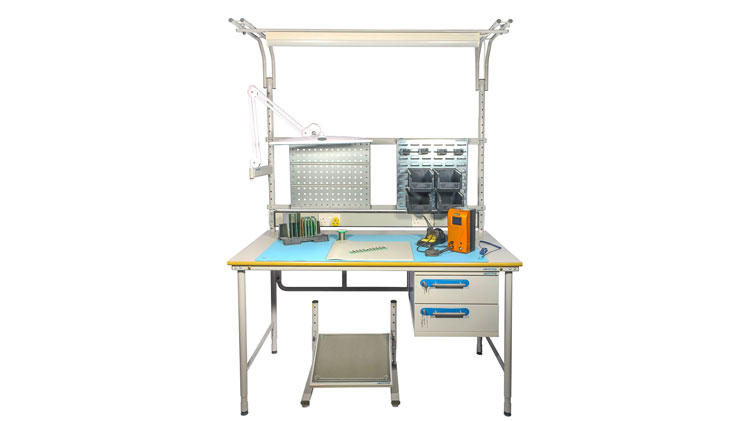5S is a methodology used in soldering and other manufacturing processes to improve efficiency and productivity. The term "5S" comes from five Japanese words representing the methodology's five steps: seiri, seiton, seiso, seiketsu, and shitsuke. These steps help companies organize their workspace, reduce waste and clutter, and create a clean, safe, and efficient working environment.

The first step of 5S is seiri, which means "sorting." In this step, workers go through their workspace and identify any unnecessary items cluttering the area. These items might include old tools, unused materials, or anything unnecessary for the current manufacturing process. By removing these items, workers can create more space and make it easier to access the tools and materials that they do need.
The second step of 5S is seiton, which means "straightening." In this step, workers arrange their tools and materials in a logical and easily accessible manner. This might involve creating designated areas for different items, using labels to identify each area's contents, and ensuring that everything is organized and easy to find. By taking the time to properly arrange their tools and materials, workers can save time and reduce the risk of mistakes.
The third step of 5S is seiso, which means "sweeping" or "cleaning." In this step, workers thoroughly clean their workspace, paying particular attention to corners and other overlooked areas. By keeping their workspace clean, workers can reduce the risk of accidents and injuries and ensure a healthy and safe working environment.
The fourth step of 5S is seiketsu, which means "standardizing." In this step, workers establish standard procedures for maintaining the cleanliness and organization of their workspace. This might involve creating a schedule for regular cleaning and organizing and implementing procedures for maintaining order and preventing clutter from accumulating. By establishing standard procedures, workers can ensure that the benefits of the previous steps are sustained over time.
The fifth and final step of 5S is shitsuke, which means "sustaining" or "self-discipline." In this step, workers are encouraged to take ownership of their workspace and maintain the high standards that have been established. This might involve conducting regular audits to identify any problems or areas for improvement and addressing any identified issues. By maintaining a disciplined and self-motivated approach to their work, workers can continue to improve their efficiency and productivity.
In addition to these five steps, 5S also strongly emphasizes communication and collaboration. In a 5S environment, workers are encouraged to share ideas and suggestions for improving the manufacturing process and to work together to implement those ideas. By fostering a culture of collaboration and open communication, companies can create a more dynamic and efficient working environment.
Overall, 5S is a powerful methodology that can help companies improve the efficiency and productivity of their soldering and other manufacturing processes. By following the five steps of 5S, companies can create a clean, safe, and organized workspace and ensure that their workers have the tools and materials they need to do their jobs effectively. By maintaining a disciplined and collaborative approach to their work, companies can continue to improve their operations and achieve their goals.
In terms of soldering specifically, 5S can help companies improve the quality of their soldering work by providing a clean and organized workspace. In a soldering environment, clutter and disorganization can lead to mistakes and poor-quality work. By implementing the 5S methodology, companies can create a workspace that is free of distractions and distractions, and that allows workers to focus on their soldering tasks.
In addition, 5S can also help companies reduce waste and improve efficiency in their soldering processes. By removing unnecessary items and organizing the workspace, companies can reduce workers' time searching for tools and materials and make it easier for workers to access the items they need. This can help reduce the amount of time and resources wasted on unnecessary tasks and improve the overall efficiency of the soldering process.
Furthermore, 5S can help companies create a safer working environment for their soldering workers. Soldering involves the use of heat and potentially dangerous chemicals, and a cluttered workspace can increase the risk of accidents and injuries. By implementing 5S, companies can create a workspace that is free of clutter and hazards and allows workers to focus on their soldering tasks without the risk of accidents.
Overall, the 5S methodology is an important tool for companies looking to improve their soldering processes' quality, efficiency, and safety. By implementing the five steps of 5S, companies can create a clean, organized, and safe workspace and ensure that their workers have the tools and resources to do their jobs effectively. By maintaining a disciplined and collaborative approach to their work, companies can continue to improve their soldering operations and achieve their goals.
Contact: Mr. Li
Phone: (0086) 138 24254 321
E-mail: atetool@atetool.com.cn
Add: 5F, 1-2# Building, Tongfuyu Industrial Zone, Aiqun Rd, Shiyan Subdistrict, Bao'an, Shenzhen, 518108, China